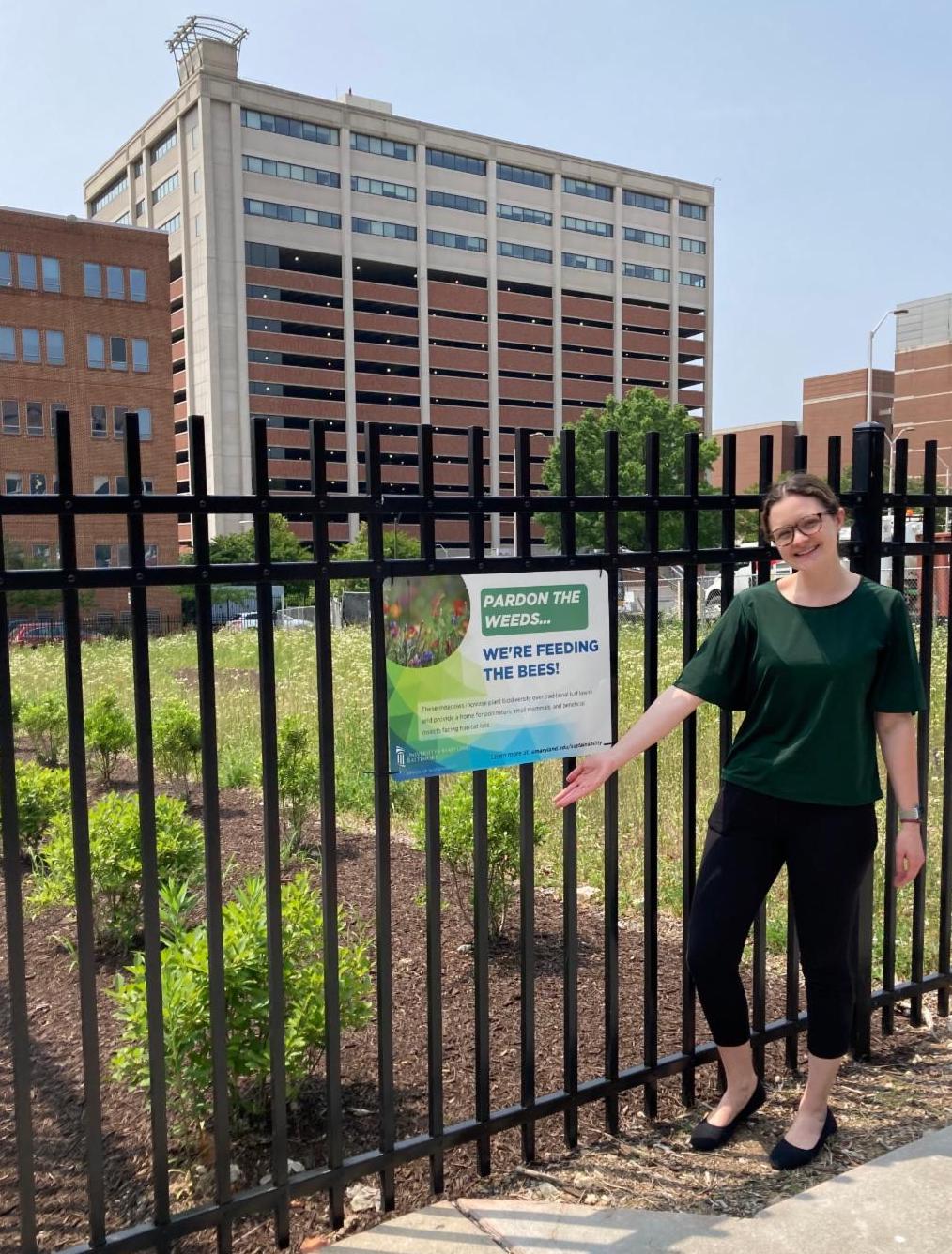Getting Into the Weeds: Ecological Landscaping at UMB
July 10, 2024 Meredith DiIoia
Learn about our intentional landscape design principles on campus and ways you can implement sustainable practices in your own garden or yard.
Photo: Elizabeth Main, MPA, director of sustainability and special projects, poses near a sign explaining the native plantings.
Have you noticed some green areas around the University of Maryland, Baltimore (UMB) campus that look a little less polished than others? These aren’t overgrown weeds, but are intentional areas where UMB has shifted to more native plantings.
While traditional plantings like grass lawns and annual flowers are visually attractive, ecological landscaping promotes biodiversity, attracts pollinators, reduces water and air pollution, and creates habitable ecosystems in our urban environment. Ecological landscaping moves past the idea that landscapes are solely for our viewing purposes, but rather they are growing, diverse ecosystems that support far greater purposes than just curb appeal.
As a state institution, it is UMB’s responsibility to promote and follow guidelines set by the state of Maryland. Maryland law requires that each state agency prioritizes the use of plants native to the state for every planting project. The state’s landscaping guidelines also heavily promote the prioritization of environmentally preferable landscaping practices, including limiting the use of fertilizers, pesticides, and mowing.
According to Maryland’s Department of General Services, “By selecting native plants for State grounds, our green spaces can act as a natural buffer in preventing pollution runoff and erosion while serving as habitats and food sources for wildlife.”
UMB has integrated thoughtful design into its landscaping approach to provide more green space on campus, whether that be a small bump-out to incorporate a flower garden along walking paths, finding creative solutions to lessen the impervious area on campus, or saving older trees from new construction and “recycling” them by placing them in other spaces.
We follow the state of Maryland’s specifications by replacing non-native trees, shrubs, and other plantings with natives where possible, planting perennials in place of annuals, and using innovative landscaping techniques to reduce soil nutrient loss.
Stormwater management on campus also provides opportunities for additional greenery and usage of native plants. The next time you walk around campus, take a closer look. An area that might look like a simple garden could actually be working hard to help manage and treat rainwater.
BrightView, our campus landscaping contractor, also emphasizes ecological values throughout its projects, constantly striving to minimize the impact of its work on the environment by utilizing innovative techniques and efficient equipment.
“When established, native landscaping is typically more resilient to environmental stress and requires less water and pesticides — and therefore money — to maintain, all while providing that important pollinator habitat,” says Mark Drymala, MS, assistant director, Environmental Services.
“ ‘Save the bees’ has become somewhat of a cliché these days, but this is truly a vital endeavor if we want to continue to feed ourselves and is just one benefit of planting natives. The urban environment poses many challenges — especially habitat fragmentation — but we hope our efforts can partially overcome this hurdle and, in the process, inspire others to plant natives at home.”
If you have a yard or garden at home, transitioning it to a more biodiverse, less-manicured landscape can assist in bringing pollinators to your home, as well as reduce the cost and time spent on maintenance. One tip is to use native plants, which usually require no fertilizer and will attract pollinators.
One example of a native plant is milkweed, which will attract monarch butterflies to your space. If you want to see more birds, plant a shrub like winterberry, which produces fruit for birds in the winter. If you are worried about flooding in your area, tall grasses, shrubs, and trees all help to absorb stormwater runoff.
The Office of Sustainability recommends shopping at a local store like Herring Run Nursery, which specializes in plants native to the Chesapeake Bay watershed. Some of the office’s favorite native plants are species of Serviceberry, Little Bluestem, Phlox, Pink Muhly Grass, and Stonecrop. If these don’t fit your space, look at all the native plant options in our watershed and pick the ones that best fit your needs!